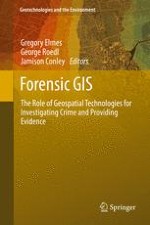2014 | OriginalPaper | Chapter
7. The SDIK Police Model: How to Make the Invisible Visible
Authors : Manuel Rodríguez Herrera, Daniel Salafranca Barreda
Published in: Forensic GIS
Publisher: Springer Netherlands
Activate our intelligent search to find suitable subject content or patents.
Select sections of text to find matching patents with Artificial Intelligence. powered by
Select sections of text to find additional relevant content using AI-assisted search. powered by
